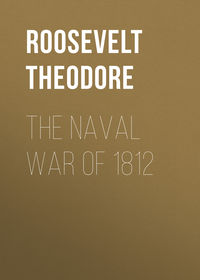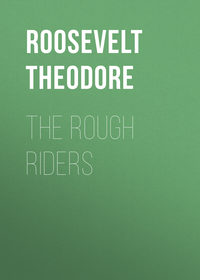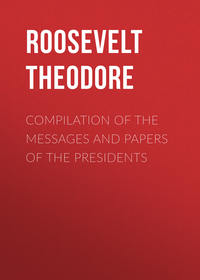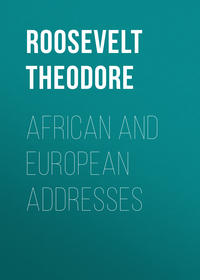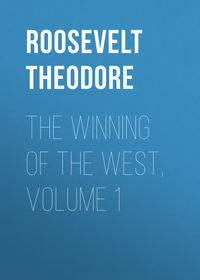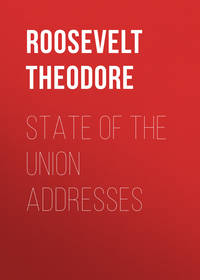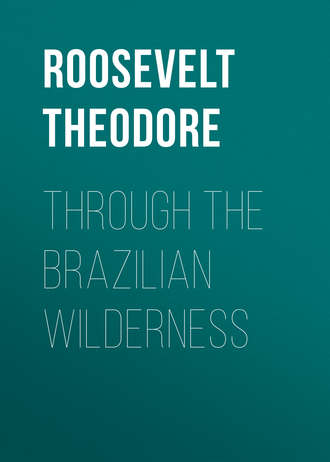 полная версия
полная версияThrough the Brazilian Wilderness
We had been two months in the canoes; from the 27th of February to the 26th of April. We had gone over 750 kilometres. The river from its source, near the thirteenth degree, to where it became navigable and we entered it, had a course of some 200 kilometres—probably more, perhaps 300 kilometres. Therefore we had now put on the map a river nearly 1,000 kilometres in length of which the existence was not merely unknown but impossible if the standard maps were correct. But this was not all. It seemed that this river of 1,000 kilometres in length was really the true upper course of the Aripuanan proper, in which case the total length was nearly 1,500 kilometres. Pyrineus had been waiting for us over a month, at the junction of what the rubbermen called the Castanho and of what they called the upper Aripuanan. (He had no idea as to which stream we would appear upon, or whether we would appear upon either.) On March 26 he had measured the volume of the two, and found that the Castanho, although the narrower, was the deeper and swifter, and that in volume it surpassed the other by 84 cubic metres a second. Since then the Castanho had fallen; our measurements showed it to be slightly smaller than the other; the volume of the river after the junction was about 4,500 cubic metres a second. This was in 7 degrees 34 minutes.
We were glad indeed to see Pyrineus and be at his attractive camp. We were only four hours above the little river hamlet of Sao Joao, a port of call for rubber-steamers, from which the larger ones go to Manaos in two days. These steamers mostly belong to Senhor Caripe. From Pyrineus we learned that Lauriado and Fiala had reached Manaos on March 26. On the swift water in the gorge of the Papagaio Fiala's boat had been upset and all his belongings lost, while he himself had narrowly escaped with his life. I was glad indeed that the fine and gallant fellow had escaped. The Canadian canoe had done very well. We were no less rejoiced to learn that Amilcar, the head of the party that went down the Gy-Parana, was also all right, although his canoe too had been upset in the rapids, and his instruments and all his notes lost. He had reached Manaos on April 10. Fiala had gone home. Miller was collecting near Manaos. He had been doing capital work.
The piranhas were bad here, and no one could bathe. Cherrie, while standing in the water close to the shore, was attacked and bitten; but with one bound he was on the bank before any damage could be done.
We spent a last night under canvas, at Pyrineus' encampment. It rained heavily. Next morning we all gathered at the monument which Colonel Rondon had erected, and he read the orders of the day. These recited just what had been accomplished: set forth the fact that we had now by actual exploration and investigation discovered that the river whose upper portion had been called the Duvida on the maps of the Telegraphic Commission and the unknown major part of which we had just traversed, and the river known to a few rubbermen, but to no one else, as the Castanho, and the lower part of the river known to the rubbermen as the Aripuanan (which did not appear on the maps save as its mouth was sometimes indicated, with no hint of its size) were all parts of one and the same river; and that by order of the Brazilian Government this river, the largest affluent of the Madeira, with its source near the 13th degree and its mouth a little south of the 5th degree, hitherto utterly unknown to cartographers and in large part utterly unknown to any save the local tribes of Indians, had been named the Rio Roosevelt.
We left Rondon, Lyra, and Pyrineus to take observations, and the rest of us embarked for the last time on the canoes, and, borne swiftly on the rapid current, we passed over one set of not very important rapids and ran down to Senhor Caripe's little hamlet of Sao Joao, which we reached about one o'clock on April 27, just before a heavy afternoon rain set in. We had run nearly eight hundred kilometres during the sixty days we had spent in the canoes. Here we found and boarded Pyrineus's river steamer, which seemed in our eyes extremely comfortable. In the senhor's pleasant house we were greeted by the senhora, and they were both more than thoughtful and generous in their hospitality. Ahead of us lay merely thirty-six hours by steamer to Manaos. Such a trip as that we had taken tries men as if by fire. Cherrie had more than stood every test; and in him Kermit and I had come to recognize a friend with whom our friendship would never falter or grow less.
Early the following afternoon our whole party, together with Senhor Caripe, started on the steamer. It took us a little over twelve hours' swift steaming to run down to the mouth of the river on the upper course of which our progress had been so slow and painful; from source to mouth, according to our itinerary and to Lyra's calculations, the course of the stream down which we had thus come was about 1,500 kilometres in length—about 900 miles, perhaps nearly 1,000 miles— from its source near the 13th degree in the highlands to its mouth in the Madeira, near the 5th degree. Next morning we were on the broad sluggish current of the lower Madeira, a beautiful tropical river. There were heavy rainstorms, as usual, although this is supposed to be the very end of the rainy season. In the afternoon we finally entered the wonderful Amazon itself, the mighty river which contains one tenth of all the running water of the globe. It was miles across, where we entered it; and indeed we could not tell whether the farther bank, which we saw, was that of the mainland or an island. We went up it until about midnight, then steamed up the Rio Negro for a short distance, and at one in the morning of April 30 reached Manaos.
Manaos is a remarkable city. It is only three degrees south of the equator. Sixty years ago it was a nameless little collection of hovels, tenanted by a few Indians and a few of the poorest class of Brazilian peasants. Now it is a big, handsome modern city, with Opera house, tramways, good hotels, fine squares and public buildings, and attractive private houses. The brilliant coloring and odd architecture give the place a very foreign and attractive flavor in northern eyes. Its rapid growth to prosperity was due to the rubber trade. This is now far less remunerative than formerly. It will undoubtedly in some degree recover; and in any event the development of the immensely rich and fertile Amazonian valley is sure to go on, and it will be immensely quickened when closer connections are made with the Brazilian highland country lying south of it.
Here we found Miller, and glad indeed we were to see him. He had made good collections of mammals and birds on the Gy-Parana, the Madeira, and in the neighborhood of Manaos; his entire collection of mammals was really noteworthy. Among them was the only sloth any of us had seen on the trip. The most interesting of the birds he had seen was the hoatzin. This is a most curious bird of very archaic type. Its flight is feeble, and the naked young have spurs on their wings, by the help of which they crawl actively among the branches before their feathers grow. They swim no less easily, at the same early age. Miller got one or two nests, and preserved specimens of the surroundings of the nests; and he made exhaustive records of the habits of the birds. Near Megasso a jaguar had killed one of the bullocks that were being driven along for food. The big cat had not seized the ox with its claws by the head, but had torn open its throat and neck.
Every one was most courteous at Manaos, especially the governor of the state and the mayor of the city. Mr. Robiliard, the British consular representative, and also the representative of the Booth line of steamers, was particularly kind. He secured for us passages on one of the cargo boats of the line to Para, and thence on one of the regular cargo-and-passenger steamers to Barbados and New York. The Booth people were most courteous to us.
I said good-by to the camaradas with real friendship and regret. The parting gift I gave to each was in gold sovereigns; and I was rather touched to learn later that they had agreed among themselves each to keep one sovereign as a medal of honor and token that the owner had been on the trip. They were a fine set, brave, patient, obedient, and enduring. Now they had forgotten their hard times; they were fat from eating, at leisure, all they wished; they were to see Rio Janeiro, always an object of ambition with men of their stamp; and they were very proud of their membership in the expedition.
Later, at Belen, I said good-by to Colonel Rondon, Doctor Cajazeira, and Lieutenant Lyra. Together with my admiration for their hardihood, courage, and resolution, I had grown to feel a strong and affectionate friendship for them. I had become very fond of them; and I was glad to feel that I had been their companion in the performance of a feat which possessed a certain lasting importance.
On May 1 we left Manaos for Belen-Para, as until recently it was called. The trip was interesting. We steamed down through tempest and sunshine; and the towering forest was dwarfed by the giant river it fringed. Sunrise and sunset turned the sky to an unearthly flame of many colors above the vast water. It all seemed the embodiment of loneliness and wild majesty. Yet everywhere man was conquering the loneliness and wresting the majesty to his own uses. We passed many thriving, growing towns; at one we stopped to take on cargo. Everywhere there was growth and development. The change since the days when Bates and Wallace came to this then poor and utterly primitive region is marvellous. One of its accompaniments has been a large European, chiefly south European, immigration. The blood is everywhere mixed; there is no color line, as in most English-speaking countries, and the negro and Indian strains are very strong; but the dominant blood, the blood already dominant in quantity, and that is steadily increasing its dominance, is the olive-white.
Only rarely did the river show its full width. Generally we were in channels or among islands. The surface of the water was dotted with little islands of floating vegetation. Miller said that much of this came from the lagoons such as those where he had been hunting, beside the Solimoens—lagoons filled with the huge and splendid Victoria lily, and with masses of water hyacinths. Miller, who was very fond of animals and always took much care of them, had a small collection which he was bringing back for the Bronx Zoo. An agouti was so bad- tempered that he had to be kept solitary; but three monkeys, big, middle-sized, and little, and a young peccary formed a happy family. The largest monkey cried, shedding real tears, when taken in the arms and pitied. The middle-sized monkey was stupid and kindly, and all the rest of the company imposed on it; the little monkey invariably rode on its back, and the peccary used it as a head pillow when it felt sleepy.
Belen, the capital of the state of Para, was an admirable illustration of the genuine and almost startling progress which Brazil has been making of recent years. It is a beautiful city, nearly under the equator. But it is not merely beautiful. The docks, the dredging operations, the warehouses, the stores and shops, all tell of energy and success in commercial life. It is as clean, healthy, and well policed a city as any of the size in the north temperate zone. The public buildings are handsome, the private dwellings attractive; there are a fine opera-house, an excellent tramway system, and a good museum and botanical gardens. There are cavalry stables, where lights burn all night long to protect the horses from the vampire bats. The parks, the rows of palms and mango-trees, the open-air restaurants, the gay life under the lights at night, all give the city its own special quality and charm. Belen and Manaos are very striking examples of what can be done in the mid-tropics. The governor of Para and his charming wife were more than kind.
Cherrie and Miller spent the day at the really capital zoological gardens, with the curator, Miss Snethlage. Miss Snethlage, a German lady, is a first rate field and closet naturalist, and an explorer of note, who has gone on foot from the Xingu to the Tapajos. Most wisely she has confined the Belen zoo to the animals of the lower Amazon valley, and in consequence I know of no better local zoological gardens. She has an invaluable collection of birds and mammals of the region; and it was a privilege to meet her and talk with her.
We also met Professor Farrabee, of the University of Pennsylvania, the ethnologist. He had just finished a very difficult and important trip, from Manaos by the Rio Branco to the highlands of Guiana, across them on foot, and down to the seacoast of British Guiana. He is an admirable representative of the men who are now opening South America to scientific knowledge.
On May 7 we bade good-by to our kind Brazilian friends and sailed northward for Barbados and New York.
Zoologically the trip had been a thorough success. Cherrie and Miller had collected over twenty-five hundred birds, about five hundred mammals, and a few reptiles, batrachians, and fishes. Many of them were new to science; for much of the region traversed had never previously been worked by any scientific collector.
Of course, the most important work we did was the geographic work, the exploration of the unknown river, undertaken at the suggestion of the Brazilian Government, and in conjunction with its representatives. No piece of work of this kind is ever achieved save as it is based on long continued previous work. As I have before said, what we did was to put the cap on the pyramid that had been built by Colonel Rondon and his associates of the Telegraphic Commission during the six previous years. It was their scientific exploration of the chapadao, their mapping the basin of the Juruena, and their descent of the Gy- Parana that rendered it possible for us to solve the mystery of the River of Doubt.
The work of the commission, much the greatest work of the kind ever done in South America, is one of the many, many achievements which the republican government of Brazil has to its credit. Brazil has been blessed beyond the average of her Spanish-American sisters because she won her way to republicanism by evolution rather than revolution. They plunged into the extremely difficult experiment of democratic, of popular, self-government, after enduring the atrophy of every quality of self-control, self-reliance, and initiative throughout three withering centuries of existence under the worst and most foolish form of colonial government, both from the civil and the religious standpoint, that has ever existed. The marvel is not that some of them failed, but that some of them have eventually succeeded in such striking fashion. Brazil, on the contrary, when she achieved independence, first exercised it under the form of an authoritative empire, then under the form of a liberal empire. When the republic came, the people were reasonably ripe for it. The great progress of Brazil—and it has been an astonishing progress—has been made under the republic. I could give innumerable examples and illustrations of this. The change that has converted Rio Janeiro from a picturesque pest-hole into a singularly beautiful, healthy, clean, and efficient modern great city is one of these. Another is the work of the Telegraphic Commission.
We put upon the map a river some fifteen hundred kilometres in length, of which the upper course was not merely utterly unknown to, but unguessed at by, anybody; while the lower course, although known for years to a few rubbermen, was utterly unknown to cartographers. It is the chief affluent of the Madeira, which is itself the chief affluent of the Amazon.
The source of this river is between the 12th and 13th parallels of latitude south and the 59th and 60th degrees of longitude west from Greenwich. We embarked on it at about latitude 12 degrees 1 minute south, and about longitude 60 degrees 15 minutes west. After that its entire course lay between the 60th and 61st degrees of longitude, approaching the latter most closely about latitude 8 degrees 15 minutes. The first rapids we encountered were in latitude 11 degrees 44 minutes, and in uninterrupted succession they continued for about a degree, without a day's complete journey between any two of them. At 11 degrees 23 minutes the Rio Kermit entered from the left, at 11 degrees 22 minutes the Rio Marciano Avila from the right, at 11 degrees 18 minutes the Taunay from the left, at 10 degrees 58 minutes the Cardozo from the right. In 10 degrees 24 minutes we encountered the first rubbermen. The Rio Branco entered from the left at 9 degrees 38 minutes. Our camp at 8 degrees 49 minutes was nearly on the boundary between Matto Grosso and Amazonas. The confluence with the Aripuanan, which joined from the right, took place at 7 degrees 34 minutes. The entrance into the Madeira was at about 5 degrees 20 minutes (this point we did not determine by observation, as it is already on the maps). The stream we had followed down was from the river's highest sources; we had followed its longest course.
APPENDIX A
The Work of the Field Zoologist and Field Geographer in South AmericaPortions of South America are now entering on a career of great social and industrial development. Much remains to be known, so far as the outside world is concerned, of the social and industrial condition in the long-settled interior regions. More remains to be done, in the way of pioneer exploring and of scientific work, in the great stretches of virgin wilderness. The only two other continents where such work, of like volume and value, remains to be done are Africa and Asia; and neither Africa nor Asia offers a more inviting field for the best kind of field worker in geographical exploration and in zoological, geological, and paleontological investigation. The explorer is merely the most adventurous kind of field geographer; and there are two or three points worth keeping in mind in dealing with the South American work of the field geographer and field zoologist.
Roughly, the travellers who now visit (like those who for the past century have visited) South America come in three categories— although, of course, these categories are not divided by hard-and-fast lines.
First, there are the travellers who skirt the continent in comfortable steamers, going from one great seaport to another, and occasionally taking a short railway journey to some big interior city not too far from the coast. This is a trip well worth taking by all intelligent men and women who can afford it; and it is being taken by such men and women with increasing frequency. It entails no more difficulty than a similar trip to the Mediterranean—than such a trip which to a learned and broad-minded observer offers the same chance for acquiring knowledge and, if he is himself gifted with wisdom, the same chance of imparting his knowledge to others that is offered by a trip of similar length through the larger cities of Europe or the United States. Probably the best instance of the excellent use to which such an observer can put his experience is afforded by the volume of Mr. Bryce. Of course, such a trip represents travelling of essentially the same kind as travelling by railroad from Atlanta to Calgary or from Madrid to Moscow.
Next there are the travellers who visit the long-settled districts and colonial cities of the interior, travelling over land or river highways which have been traversed for centuries but which are still primitive as regards the inns and the modes of conveyance. Such travelling is difficult in the sense that travelling in parts of Spain or southern Italy or the Balkan states is difficult. Men and women who have a taste for travel in out-of-way places and who, therefore, do not mind slight discomforts and inconveniences have the chance themselves to enjoy, and to make others profit by, travels of this kind in South America. In economic, social, and political matters the studies and observations of these travellers are essential in order to supplement, and sometimes to correct, those of travellers of the first category; for it is not safe to generalize overmuch about any country merely from a visit to its capital or its chief seaport. These travellers of the second category can give us most interesting and valuable information about quaint little belated cities; about backward country folk, kindly or the reverse, who show a mixture of the ideas of savagery with the ideas of an ancient peasantry; and about rough old highways of travel which in comfort do not differ much from those of mediaeval Europe. The travellers who go up or down the highway rivers that have been travelled for from one to four hundred years—rivers like the Paraguay and Parana, the Amazon, the Tapajos, the Madeira, the lower Orinoco—come in this category. They can add little to our geographical knowledge; but if they are competent zoologists or archaeologists, especially if they live or sojourn long in a locality, their work may be invaluable from the scientific standpoint. The work of the archaeologists among the immeasurably ancient ruins of the low-land forests and the Andean plateaux is of this kind. What Agassiz did for the fishes of the Amazon and what Hudson did for the birds of the Argentine are other instances of the work that can thus be done. Burton's writings on the interior of Brazil offer an excellent instance of the value of a sojourn or trip of this type, even without any especial scientific object.
Of course travellers of this kind need to remember that their experiences in themselves do not qualify them to speak as wilderness explorers. Exactly as a good archaeologist may not be competent to speak of current social or political problems, so a man who has done capital work as a tourist observer in little-visited cities and along remote highways must beware of regarding himself as being thereby rendered fit for genuine wilderness work or competent to pass judgment on the men who do such work. To cross the Andes on mule-back along the regular routes is a feat comparable to the feats of the energetic tourists who by thousands traverse the mule trails in out-of-the-way nooks of Switzerland. An ordinary trip on the highway portions of the Amazon, Paraguay, or Orinoco in itself no more qualifies a man to speak of or to take part in exploring unknown South American rivers than a trip on the lower Saint Lawrence qualifies a man to regard himself as an expert in a canoe voyage across Labrador or the Barren Grounds west of Hudson Bay.
A hundred years ago, even seventy or eighty years ago, before the age of steamboats and railroads, it was more difficult than at present to define the limits between this class and the next; and, moreover, in defining these limits I emphatically disclaim any intention of thereby attempting to establish a single standard of value for books of travel. Darwin's "Voyage of the Beagle" is to me the best book of the kind ever written; it is one of those classics which decline to go into artificial categories, and which stand by themselves; and yet Darwin, with his usual modesty, spoke of it as in effect a yachting voyage. Humboldt's work had a profound effect on the thought of the civilized world; his trip was one of adventure and danger; and yet it can hardly be called exploration proper. He visited places which had been settled and inhabited for centuries and traversed places which had been travelled by civilized men for years before he followed in their footsteps. But these places were in Spanish colonies, and access to them had been forbidden by the mischievous and intolerant tyranny— ecclesiastical, political, and economic—which then rendered Spain the most backward of European nations; and Humboldt was the first scientific man of intellectual independence who had permission to visit them. To this day many of his scientific observations are of real value. Bates came to the Amazon just before the era of Amazonian steamboats. He never went off the native routes of ordinary travel. But he was a devoted and able naturalist. He lived an exceedingly isolated, primitive, and laborious life for eleven years. Now, half a century after it was written, his "Naturalist on the Amazon" is as interesting and valuable as it ever was, and no book since written has in any way supplanted it.
Travel of the third category includes the work of the true wilderness explorers who add to our sum of geographical knowledge and of the scientific men who, following their several bents, also work in the untrodden wilds. Colonel Rondon and his associates have done much in the geographical exploration of unknown country, and Cherrie and Miller have penetrated and lived for months and years in the wastes, on their own resources, as incidents to their mammalogical and ornithological work. Professor Farrabee, the anthropologist, is a capital example of the man who does this hard and valuable type of work.



